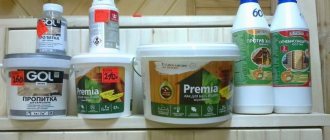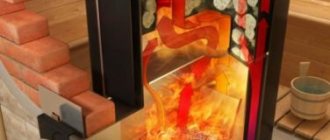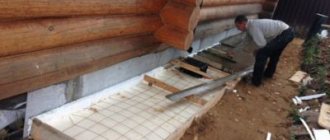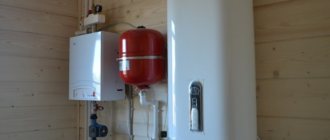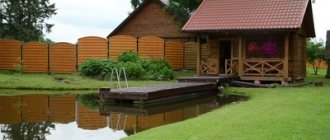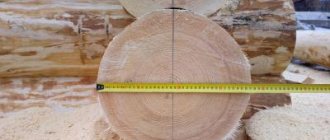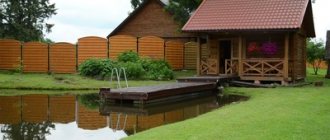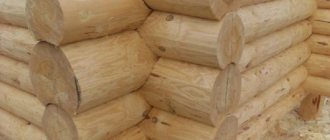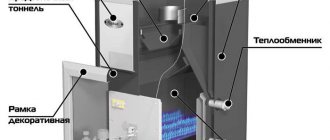Protective screens for sauna stoves are made from various non-combustible materials in compliance with certain air gaps. Also often, in order to create an effective thermal barrier, a reflective sheet of polished stainless steel is placed between the wall and the metal stove at a certain distance from the protected surface and the heated body of the stove. Another common option for thermal protection is to install a brick wall between the stove and the flammable exterior wall finish, but this solution is quite labor-intensive and requires certain skills.
Distance from stove to wall
The most durable and reliable barrier that prevents excessive heating of the wall surface from the heat of the stove is the air space between them. If all distances established by standard regulatory documents are observed, you can be 100% sure that there is no reason to fear the walls heating up from the stove body.
According to standards taken from SNiP 2.04.05-91, the distance from the stove to an unprotected wall with a fire resistance limit of REI 60 must be at least 500 mm (in diagram A
), that is, half a meter.
If you install a dense sheet of non-combustible material (minerite or glass-magnesite) on the wall and additionally attach a reflective layer of stainless steel to it, then this standard distance is reduced to 380 mm (in diagram B
).
The dimensions of the parts of the protective screen structure that protrude beyond the dimensions of the furnace are also regulated (in diagram C
).
This distance should be taken into account when calculating the material to a value of at least 150 mm. As for the distance from the firebox door to the wall opposite it, it cannot be less than 1250 mm (in diagram F
).
Of course, this is not an excuse for violating fire safety standards established by special responsible authorities based on experimental scientific research. At the same time, manufacturers of Finnish stoves indicate other numbers in the technological documents for their products for the safe placement of their metal stoves in the walls of the steam room. For example, when installing a protective screen, the permissible distance to the wall is only 250 mm.
Protective screen manufacturing technology
The basis for creating a thermal barrier is sheet non-combustible material. Glass-magnesite (SML) or mineralite slabs are used as such materials. Their installation is carried out through a sleeve, on a wooden frame or directly on the wall surface. The safest way to install this protective layer is to install it on self-tapping screws through a special metal or ceramic sleeve with a length of 3 cm. An example of the location of the thermal barrier with an illustration of the appearance of the sleeve is shown in the image below.
Which brick is preferable?
Bricks are different. It is better to use those that have the most suitable properties.
Remember! Silicate (white) is not suitable as a screen. A material based on lime, under the influence of constant humidity and temperature fluctuations, will quickly lose strength, crack, or even collapse.
*
We recommend using solid ceramic (red) bricks to construct the protection. It is characterized by:
- heat resistance;
- thermal capacity and excellent heat transfer;
- aesthetic performance; By using facing materials, you can achieve a very attractive design.
Hollow “ceramics” with a similar structure are also quite suitable for the stated purposes. But it is distinguished by a shorter service life, due to its response to temperature fluctuations and less thermal accumulation.
Is it possible to lay fireclay bricks? Yes, it will also serve as good protection. But its use is inappropriate in most cases. The high cost of the material and not so high heat capacity make fireclay a less preferable option.
Note! Fireclay brick is suitable for constructing a screen in rooms designed for higher temperatures.
Screen for sauna stove: types and placement
A steam room in a bathhouse is a room with an elevated temperature, which is created and maintained by a stove. In addition to heat, this device emits a large amount of infrared radiation, which also increases heating. That is why it is necessary to choose the right screen for the stove in the bathhouse in order to obtain reliable protection from this influence and at the same time not reduce the intensity of air heating.
Amateur photo of a protective screen designed to remove heat from wooden surfaces
Conclusion
The importance of the above-mentioned bath structure cannot be overestimated, therefore the design of this stage of construction should be carried out at the very beginning. Remember that the safety you provide is exactly the factor that will allow you to enjoy the bathhouse and your work for many years! During the heating of the bath, the surface of the stove heats up to 300-400°C
At the same time, it begins to emit infrared rays and itself becomes a source of heating. The coming heat is distributed throughout the steam room, but first of all it hits the walls adjacent to the stove. If the walls are wooden, then under the influence of high temperatures their charring begins. And there it’s already a stone’s throw away! The only truly effective way to insulate wooden walls from heat is to create protective screens and cladding from non-combustible materials in the bathhouse.
During the heating of the bath, the surface of the stove heats up to 300-400°C. At the same time, it begins to emit infrared rays and itself becomes a source of heating. The coming heat is distributed throughout the steam room, but first of all it hits the walls adjacent to the stove. If the walls are wooden, then under the influence of high temperatures their charring begins. And there it’s already a stone’s throw away! The only truly effective way to insulate wooden walls from heat is to create protective screens and cladding from non-combustible materials in the bathhouse.
Types of structures
To begin with, it is necessary to say that there are two types of similar structures that have a similar purpose and at the same time can perform different additional functions. Modern protective screens for sauna stoves quite often combine several different materials and are made in accordance with the design of the stove.
Taking into account these features, the craftsmen try to combine all the properties of similar products in order to achieve maximum results.
Full brick lining will allow for insulation around the entire perimeter of the device
Brick walls and trim
- Very often when creating ovens with their own hands, craftsmen resort to creating brick screens.
- Usually this is a partition that separates the metal product from the walls. It prevents the spread of infrared radiation to wooden surfaces and protects them from high temperatures that can lead to fire.
- The installation instructions also advise installing such structures between metal sauna stoves and the place where people will be. So intense radiation will heat the partition, which will play the role of an additional heater. However, it is worth remembering that when using a simple wall, you should leave a small air space.
The simplest brick partition can become an excellent screen
- Some craftsmen suggest immediately framing the entire sauna stove with a wall of brick or stone so that it can perform both tasks simultaneously. This way the structure will protect the walls of the room and prevent intense radiation from getting outside.
- It is worth noting that the screen for the sauna stove does not need to be used if the structure already has its own lining. This also applies to brick stoves, which actually themselves represent a firebox with thermal protection.
- For the manufacture of such structures, only red ceramic bricks or other materials with similar properties are suitable. The fact is that it tolerates moisture well and can withstand large temperature changes. Some craftsmen use special stones for this, which have low thermal conductivity and at the same time retain heat well.
Advice! When choosing a material for creating such structures, it is necessary to take into account that it must be able to withstand high humidity and even direct contact with water. It should also be remembered that the product will be exposed to high temperatures and it is desirable that it be able to maintain it for a long time.
Some craftsmen recommend simply sewing up the entire stove, which will give it a good appearance and help additionally retain heat.
Reflective surfaces
- Quite often, craftsmen recommend using a stainless steel screen for a bath. It should be noted that this metal must be perfectly polished and reflect infrared radiation.
- Such systems are usually used on back walls near stoves. They protect the surface from intense heating and at the same time redirect the heat inside the room. This allows you to reduce the cost of kindling and maintaining the regime.
Polished stainless steel screens
- Such heat-resistant screens for sauna stoves work very effectively even with brick stoves or when combined with stone partitions.
- Some manufacturers, making structures for heating baths, actively use them to improve the technical characteristics of their products. At the same time, professional craftsmen prefer to additionally mount bath screens made of stone or brick so that they absorb all the radiation, converting it into normal heating.
Screens with reflective surface
- Special attention is due to the fact that the metal also gets very hot and, if it comes into contact with wooden surfaces, can lead to a fire. That is why it is best to protect such a screen for a bath on the reverse side with heat-resistant material or create a small air gap.
- Quite often on sale you can see screens made of metal with a matte surface. Their price may be several times less, but they are less effective, and professional bath attendants claim that such screens are generally useless and only take up extra space.
- It is worth noting that such structures require periodic maintenance, since plaque and stains appear on them over time. To do this, they can be wiped with a special detergent or lemon juice.
Advice! Recently, ready-made products with a reflective surface can be purchased in stores. They are immediately placed in a heat-resistant frame and do not require additional processing. That is why it is much easier to use them.
Factory product made in the form of a fence
Purpose
A reflective screen for a bathhouse performs several functions:
- improves the appearance of the room in which the stove is located;
- protects bathhouse visitors from getting burns;
- prevents coals from falling out of an open firebox;
- directs heat flow.
The main task of the screen is to protect wooden surfaces that are located close to stove equipment from fire.
A brick screen for a sauna stove is a simple option for protecting wooden walls:
- It is not difficult to lay brickwork along the corner walls to a width slightly greater than the size of the stove and a height slightly greater than the height of the stove. Anyone can do it
- a more economical option in terms of the amount of bricks and labor costs compared to installing a brick partition
- no additional foundation is required, because the fencing masonry can be supported on the foundation of the furnace itself.
When constructing a brick screen for a sauna stove, the question arises about the mortar that needs to be used for masonry. Some people think that it is necessary to make the mortar according to the old recipe with clay, because, like, the cement mortar will crack. Yes, it would be nice to use a special solution for brick stoves, but only professional stove makers with extensive practical experience can work with it, and beginners will have a hard time.
Therefore, do not complicate it and do not make the problem because of the mortar: lay the bricks on a regular cement-sand mortar: if the seams are kept minimal (6-8mm), then there will be nothing to crack. This is not a stove, but just a protective screen that does not carry any load.
It needs to be folded at a distance of 10-12cm from the wooden wall for its ventilation, and it is also necessary to move away from the metal of the stove at a distance of 8-10cm so that air circulates along the surfaces of the stove.
The enclosure of a sauna stove in a steam room can perform several functions at once:
- Protecting all bathhouse visitors from accidental burns;
- Improving the visual qualities of the bath interior;
- Adjusting the heat flow in the bath.
How to make a screen for a sauna stove - options and solutions from an expert
In a home bath there is always some possibility of a burn from careless handling of the stove. This is a fairly serious danger - the operating temperature of the sauna stove is very high. However, this problem can be solved very easily by installing protective screens for sauna stoves, which will be discussed in this article.
The screen for a sauna stove simultaneously functions as a fence and protection. The fact is that the fire-resistant shield is mounted in those areas where contact is possible between the walls of the steam room, various objects located in the room, and the stove itself. It is worth noting that the protective fence does not block the passage of heat into the steam room, but only protects the stove from contact.
Stove cladding options in photographs
Below are ready-made options for cladding stoves that will fit perfectly into the interior of frame baths, as well as baths made of logs and blocks. The furnace firebox is located both in the steam room and in the dressing room.
Selecting a protective screen
Before installing protective screens in the bathhouse, you need to choose the right design. The choice is influenced by a lot of different parameters, ranging from the material of the heating device and its power, ending with the heating temperature and other factors.
To create the most effective and reliable screen for a sauna stove, you need to consider the following indicators:
- The degree of heat resistance of the material;
- Difficulty in installing the selected design;
- Wear resistance and resistance to temperature changes, since the operating conditions of protective screens are quite unfavorable;
- The cost of the material, on which its effectiveness often depends.
Heat-resistant screens for sauna stoves are divided into two types depending on the material used:
- Screens made of basalt cardboard . The average thickness of such protection is about 10 mm. Such designs are quite reliable, practical and convenient. During installation, the material is installed at an angle to the furnace equipment.
- Brick screens . The laying of brick reflectors is carried out at the stage of construction of the bathhouse - brick protection weighs a lot, so there must be a reliable foundation under it. If you equip such protection after installing the bathhouse itself, then the installation process will be complicated. In addition, it is worth remembering that sand-lime bricks are not suitable for protection, so you will have to use red or clinker products.
When planning a protective screen, you should pay attention to the decorative qualities of the building. The fact is that the outer lining of the stove can act as protection, which will significantly increase the visual quality of the interior - just look at any photos with a similar design.
To arrange protection, solid oven materials are most often used, which are laid with a row bandage. To lay them, a special solution is used, mixed in a ratio of 1:30:10 (cement, sand and clay, respectively).
Naturally, during installation it is necessary to take into account the expansion of steel sheets when exposed to temperature, so leave a section of three rows on top of the masonry. This rule applies only to brick sauna stoves.
In the case of metal stoves, you can use one of the following schemes:
- Protective screen for the case . This protection, which is usually made of brick, blocks the heat generated by the stove body.
- Protective screen for nearby walls . Using similar screens made of fire-resistant materials, the walls adjacent to the sauna stove are covered.
- Floor protection . Non-combustible materials are laid on the floor - brick, porcelain stoneware, natural stone or metal sheet laid on top of a heat-insulating layer.
How to properly mix masonry mortar
For cladding, a solution of sand, cement, and clay is mixed. Clay and cement are taken in equal proportions and 30% of clean river sand is added to them.
The main condition is a uniform consistency, as thick as sour cream, without lumps.
It is better to mix the ingredients dry first, and then gradually add water. To speed up mixing, it is convenient to take a construction mixer.
Before use, let the mixture sit for about 30 minutes. You need to prepare the solution in small portions, otherwise it will thicken quickly.
A good mortar should not run off the brick.
If the thickness is insufficient, you can add a little sand.
Rules for laying a brick screen
A brick screen for a metal stove in a bathhouse is installed in compliance with certain rules that will ensure high efficiency of the design:
- A brick screen for a sauna stove cannot be laid flush against it. The distance between the masonry and the walls of the heating device must be at least 30 mm.
- in the lower part of the protective screen , which will ensure rapid heating of the steam room when starting the stove. To regulate the temperature in the steam room, the openings are equipped with stove doors.
- do-it-yourself brick screen for a sauna stove For example, to achieve maximum temperature in a steam room, the screen is made a quarter of a brick or with a large number of holes. To reduce the temperature, you need to lay protection from a whole brick - warming up will be very long, but the heat transfer time will also increase.
- When laying, a solution of clay and sand is used . If necessary, clay can be replaced with cement.
- The brick wall surrounding the sauna stove must be at least at the same height as the top edge of the firebox.
An important nuance that you need to know when installing a brick stove in a wooden bathhouse is that it can be installed next to a wall only if there is a protective screen. Of course, you can always install the stove in the center of the room, but a fence would also be a good option.
Video description
This video explains the causes of a fire in a bathhouse with improperly organized fireclay brick protection:
Among the recommendations on choosing quality materials, craftsmen note several points that will allow you to create durable and visually attractive protection. For example, stainless steel quickly becomes unattractive from frequent heating. This can be avoided by using heat-resistant metal paint or by regularly wiping the surface with household cleaners. It is recommended to cover the log house and ceilings with two layers of heat insulation for the purpose of reinsurance.
Features of installing metal protection
Installation of a metal screen is usually carried out in such a way as to create a structure like a box. The outside is stainless steel or sheet metal coated with heat-resistant paint. As a result, an air gap appears between the metal sheets, which ensures good thermal insulation.
There are holes in the lower part of the structure that provide air circulation and prevent overheating of the metal box. To implement such protection, you can use one of two schemes.
A polished metal sheet is selected, which has much better heat transfer. As a rule, such screens are used on the rear walls of the furnace, preventing heat loss. Of course, you should not attach this protection directly to the wall - the risk of fire will increase many times over.
For proper installation, it is necessary to place a non-combustible layer between the protection and the wall so that there is air space behind the sheet. There should also be a short distance from the protection to the floor - this allows air to blow across the screen, removing heat.
If necessary, a stone partition can be reinforced with a metal screen to maximize the effect. The only thing worth noting here is that a stainless steel screen for a sauna stove is much better than a screen with a matte surface, which performs its functions much worse.
To implement such a scheme, thermal insulation is first laid on the wall, and then metal protection is placed on top of it. The design will largely depend on the chosen insulation.
Depending on the selected thermal insulation, the arrangement of the protective screen will look like this:
- When using rolled material, the cladding is created in such a way that the distance between the planks is slightly less than the width of the material. The insulation is placed between the planks and fixed with special dowels with a large head.
- If mineral cardboard or asbestos sheet is used as a heat-insulating material, then it must first be attached to the wall, and the metal sheet is fixed on top.
To maximize the effectiveness of the protective barriers, it is also worth installing a floor screen that is placed under the stove.
Building a stove with a heat-resistant shield with your own hands
When deciding to equip a steam room with a heating device yourself, a simple design of a metal stove with protective brick screens will do.
For an average size steam room up to 20 sq. m, a corner-shaped sauna stove welded from sheet steel 5 mm thick . The design is simple. In the lower part there is a combustion chamber, above it there is a compartment for the internal heater. An outlet is installed on top to connect the chimney . , a water tank is located next to the heater .
Project selection
The laying of a standard screen for a sauna stove made of metal is half a brick wide . quarter brick masonry is also common ; it is lighter in weight, but has lower heat capacity and strength.
Additional aspects
It is worth understanding that not all situations require a protective screen at all. For example, for brick kilns with an initially protected firebox, fences are not required. If the screen needs to be installed, then red ceramic materials are selected for it, capable of withstanding severe temperature changes and exposure to moisture.
Often, a bathhouse screen made of stainless steel loses much of its visual quality over time. To ensure their normal decorative properties, it is necessary to periodically wipe the metal with special cleaning compounds.
Conclusion
A DIY sauna stove screen is an important sauna structure that can prevent accidental burns and balance the operation of the stove. By implementing one of the proposed schemes, you can achieve a combination of protection efficiency, good functionality of the stove and good visual qualities of the entire system.
Advantages of basalt cardboard
Thermal insulating basalt cardboard is used during the treatment of areas of thermal equipment that are extremely sensitive to elevated temperatures, such as, for example, the insulation of heating and thermal furnaces, the insulation of dampers, boilers, pipelines, and doors. Basalt sheets are used for a heat-resistant layer between the stove and the floor, pipe and roof, where other materials cannot be used. It is also used for thermal insulation of storage tanks of any type, thermal boxes, mixers and ladles. Basalt cardboard is used as part of various structures, for example, a “sandwich”, which is assembled from layers of paper and cardboard. It can also be used to insulate joints in building structures of various purposes.
Due to its environmental friendliness, this material can be used as thermal insulation for heaters, boilers, and other equipment for household purposes.
- High degree of thermal and noise insulation.
- Fire resistance.
- Environmental Safety.
- Does not affect the corrosion resistance of metals.
- Biologically stable (does not attract rodents and microorganisms).
- Retains properties at high temperatures (up to 700°C).
- It is not resistant to moisture, so additional protection is necessary.
Thermal insulation of heat pipelines, oil and gas pipelines, and other types of communications exposed to temperature changes and other aggressive factors. As an insulating and soundproofing material in the construction of structures for various purposes (industrial and residential). As a thermal insulation material for various containers, tanks, boilers, etc., provided that the surface temperature is between -180 degrees and +700 degrees. Thermal protection and insulation of refrigeration units. As fire protection for air ducts and other structures. As an insulating and soundproofing material in interfloor ceilings and wall partitions.
Basalt cardboard with foil is one of the varieties of basalt cardboard, the main feature of which is the presence of foil on one side. Like other types of similar cardboard, the material is made from basalt rock fibers, which are formed into dense sheets that can have a significant thermal insulation effect. Thanks to the foil layer, this effect is doubled, since the thermal energy is reflected into the room and is retained even better. In addition, basalt cardboard with foil can also be used as sound insulation, as it has excellent sound absorption properties.
This is a non-flammable, fireproof and fire-resistant material that practically does not absorb moisture from the air. Foil basalt cardboard fits perfectly under the screen and pre-furnace sheet to ensure maximum thermal protection of wooden surfaces in the sauna. Able to withstand temperatures up to 1000C. In terms of its characteristics, basalt cardboard is superior to the widespread asbestos cardboard; it has improved sound absorption, thermal conductivity, and service life.
Advantages of Basalt cardboard:
Environmental friendliness. Basalt cardboard is an absolutely environmentally friendly material. It does not contain or emit harmful substances even when exposed to high temperatures. It is used in industries such as microbiology, food industry, pharmaceuticals, which require stricter environmental control of production.
Heat and sound insulation. Thanks to its light fibrous structure and random arrangement of fibers, basalt cardboard has increased heat and sound insulating properties. Its use will allow you to effectively perform high-quality insulation, reducing noise levels and heat loss.
Fire safety. The use of cardboard prevents the spread of flame, which minimizes your risks. The products belong to the group of non-combustible materials (NG). The melting point of the fibers is over 1000C.
Durability. In the absence of mechanical damage, the service life of the material is unlimited.
Ease of installation. The material is easy to handle, allowing you to install it yourself.
The price is for 1 sheet of basalt cardboard.
